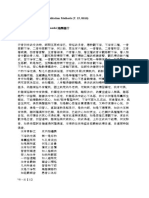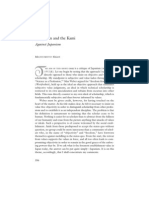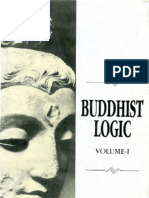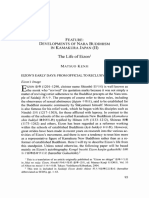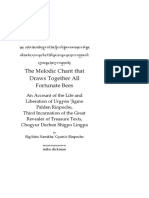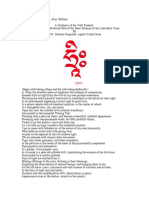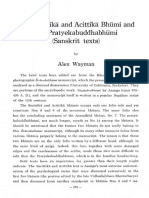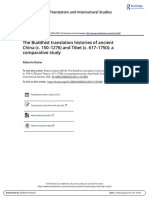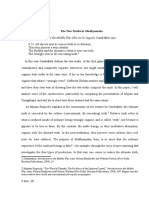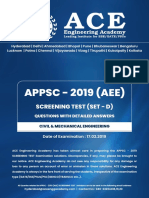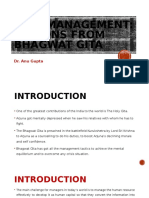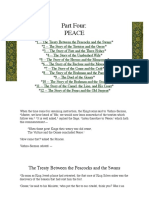Buddha Nature
Buddha Nature
Uploaded by
Bhante RewathaCopyright:
Available Formats
Buddha Nature
Buddha Nature
Uploaded by
Bhante RewathaOriginal Description:
Original Title
Copyright
Available Formats
Share this document
Did you find this document useful?
Is this content inappropriate?
Copyright:
Available Formats
Buddha Nature
Buddha Nature
Uploaded by
Bhante RewathaCopyright:
Available Formats
Rewatha 1
Introduction
The tathgatagarbha doctrine is one of the most significant Buddhist doctrines to have come under the scrutiny of scholars in recent times. According to scholars Theravadins/ Hinayanists have no the category of the "Buddha's Nature", all true Mahayanists insists that all the sentient beings possess the Buddha-nature it is Tathgatagarbha, the Embryo of the Buddhahood in all beings.
Origin of Tathgatagarbha doctrine
According to Shunko Katsumata, although the term tathgatagarbha first appeared in the Mahyna texts composed in India between approximately 200 and 350 C.E.,1 its basic idea can be found in the expressions of the early Pli stras such as Mind is pure (pabhassaram cittam).2 The concept of the pure state of mind developed into the doctrine of Buddha nature, producing the related literature, though it never formed a philosophical school in India like the Mdhyamaka and the Yogcra. 3 Further the term tathgatagarbha was an entirely new usage but its basic idea is found in the expression "prakrtiprabhsvaram cittam gantukair upakleair upakliyate", for which the same corresponding expression, or similar ones, are used sometimes in the Pali canons.4
1 2
Sallie, B. King. Buddha Nature, Albany: State University of New York, 1991. p 7 Anguttara-nikaya, 1:5; re-quoted from Shunko Katsumata, Butkyno Okeru Shinshikisetsuno Kenky [Research into the Theories of Mind and Consciousness in Buddhism](Tokyo: Sankibo Busshorin, 1988), 465. 3 Among representative tathgatagarbha texts are Tathgatagarbha-stra, Anunatvapurnatvanirdesa-stra, Mahparinirvna-stra, Lankavatara-stra, Ratnagotravibhga, Buddha-Nature Treatise, etc. Katsumata divides the process of development of tathgatagarbha thoughts in India into three steps in relation to the doctrine of layavijna and explains the representative stras and commentaries of each step: Shunko Katsumata, op. cit., 593-637. 4 Jikido Takasaki. A Study on the Ratnagotravibhaga (Being a Treatise on the Tathagatagarbha Theory of Mahyna Buddhism). Tokyo: 1964. p, 34
Rewatha 2
Pabhassaramida bhikkhave citta, taca kho gantukehi upakkilesehi upakkilihanti5 Another expression of this same idea of purification of mind seems also to be old and to have its origin in the Pali canons. "cittasamklet sattvh samkliyante, cittavyavadnd viuddhyante",6 In early Mahyna texts, no mention is made of a Buddha-element or nature (Buddha-dhtu), that is, the potential to become a Buddha. The statement that all sentient beings have the Buddhaelement first appears in the Mahyna version of the Mahparinirvna stra.7 The origin of this doctrine can be sought, however, in the statements in early Mahyna texts, such as the Astashasrikprajnpramita, that the original nature of the mind is pure, prakrtis cittasya prabhvara8 This doctrine first appeared in the Ajtasatrukaukrtyavinodana and later in many other Mahyna texts.9 The Dhranvararjastra together with the Sgaramatipariprcch, the Ratnadrik, the Ratnacda, the Gaganagaj, the Aksayamatipariprcch, etc., which form parts of the Mahsamghtastra are also standing fundamentally on the theory of the cittaprakrti, and they
5 6
Pabhassaravaggo, AN, I, 5, 9-10 (PTS, vol. 1, p. 10). Sagtakavagga SN, (PTS, vol. 3, p. 151). 7 Hirakawa, akira. A history of Indian Buddhism. Translated by Paul Groner, Delhi: Motilal Banarsidass Publishers, 1993. p 297 8 For the doctrine that the nature of the mind is originally pure, see Hirakawa akira, A history of Indian Buddhism. Translated by Paul Groner, pp. 196-217. 9 Hirakawa, akira. A history of Indian Buddhism. Translated by Paul Groner, Delhi: Motilal Banarsidass Publishers, 1993. p 297
Rewatha 3
are probably written by one and the same group who later developed the tathgatagarbha theory.10 The full form of the term bodhisattva is bodhisattva mahsattva. Bodhisattva means a being (sattva) who seeks enlightenment (Bodhi). Mahsattva means a great person and refers to a person who makes the great vow to become a Buddha and undertakes the strenuous practice required to attain the goal. A bodhisattva must believe that he has the character or nature necessary to become a Buddha.
Meaning of Tathgatagarbha
The possibility of all living beings attaining Buddhahood is a problem that seems to have been answered from two sides. One is the idea that all living beings possess Buddha- nature-the idea that is mainly advocated by the tathgata-garbha (tathgata-matrix) theory. The other is the introduction of the concept of sraya-paravrtti (the revolving of the basis).11 The concept of sraya-parvrtti12 is frequently used by the Yogcra Vijnna School that consummated the trikya doctrine. In the tathgata garbha sutra13 the Buddha has explained about tathgata garbha as when I regard all beings with my Buddha cakshur (eye), I see that hidden within the kleshas (barbs) of rga (greed), lobha (confusion), dvesha (hatred) and moha (obscuration) there is seated augustly
10 11
Jikido Takasaki. A Study on the Ratnagotravibhaga. p, 34 Madhyamika and Yogacara, A Study of Mahayana Philosophies, Collected Papers of G.M. Nagao. Sri Satguru Publication: Delhi, 1992, p.115 12 The term rayaparvrtti was used for the first time in the Strlamkra (krik) and has gradually been fixed as a technical term of the Vijnavda by Asaga and Vasubandhu, defining raya as layavijna, and that before that term was introduced, the term rayaparivrtti was commonly used by the Vijnavdins and in the Tathgatagarbha theory. 13 The Tathgatagarbhastra is a small scripture whose main part consists merely of the 9 examples illustrating the covering of defilements over the tathgatagarbha.
Rewatha 4
and un-movingly the Tathgata jnana , the Tathgata-vision and the Tathgata kaya. kulaputras, all beings, though they find themselves with all sorts of kleshas, have a tathgatagarbha that is eternally unsullied, and that is replete with virtues no different from my own.14 According to this explanation all living beings possess Buddhas nature without different from Buddhas tathgata garbha. The idea that all beings have Buddha-nature according to tathgata garbha theory, it has strongly advocated that the human mind is essentially identical with the tathgata. The essence of the human mind is transparently luminous; it has lost its light only because of its being covered with adventitious defilement ( gantuka-klesa). When the adventitious defilement has been removed, the true mind or Buddha-nature becomes apparent. Further it has explained in tathgata-garbha sutra, The Buddha can really see the beings (sattva) tathgata-garbha. And because he wants to disclose the tathgata-garbha to them, he expounds the sutras and the Dharma, in order to destroy kleshas and reveal the buddha-dhtu (buddha-element, buddha-nature). kulaputras, such is the dharma of all Buddhas. Whether or not Buddhas appear in the world, the tathgata-garbha of all beings is eternal and unchanging. It is just that they are covered by kleshas of sentient beings." es dharmnm dharmat. utpdd v tathgatnm anutpdd v sadavate sattvs tathgatagarbhh15 According to above explanation tathgata-garbha abidingly exists whether or not buddhas appear in the world. With regard to this position among the living beings one cannot escape from
14
Tathagata-garbha Sutra, (Tripitaka No. 0666) Translated during the East-JIN Dynasty by Tripitaka Master Buddhabhadra from India. 15 Tathagata-garbha Sutra,
Rewatha 5
the Buddhas nature. Just as the birds fly freely in the air, all sentient beings breathe in the Buddha-nature. For the tathgatagarbha various interpretations appeared in later ages. But its original meaning seems to have been that it was the embryo that conceived the tathgata, nurtured it, and gave birth to it. To say that a sentient being is a tathgatagarbha means that one possesses Buddha-lineage and is a member of the Buddha family ( gotra) and that one possesses Buddhaessence or Buddha-nature by birth.16
Yogcra and Tathgatagarbha doctrine
The Sandhinirmochana and Lankvatra sutras were especially influential in the formulation of the doctrines of the Yogcra school, founded by two brothers, Asanga and Vasubandu (the latter, because of his great learning, was given the singular honor of being called "the second Buddha"), natives of North-West India, in the 4th or 5th century. Another source of Yogcra teachings was Asanga's little-known teacher Maitreyantha, who has been called the true founder of the school17. Asanga is considered to be the systematizer of Yogcra-thought18 Asanga and Vasubandu were encyclopaedic systematisers, who developed ideas already established in older writings, such as the Abhidharma, the Prajnapramita, and the Lankvatra, and gave definitive form to earlier Mahayanist concepts like the ten stages (bhumis) of development of the Bodhisattva, the three "bodies" of the Buddha ( trikya), the three states or levels of self-being (swabhava), and the theory that reality is consciousness-only. 19
16
Madhyamika and Yogacara. A Study of Mahayana Philosophies, Collected Papers of G.M. Nagao. Sri Satguru Publication: Delhi, 1992, p.117 17 Chandradhar, Sharma. A Critical Survey of Indian Philosophy, p.108 18 Kalupahana, David J. (1992), The Principles of Buddhist Psychology, Delhi: Sri Satguru Publications, p.126 19 Edward, Conze. Buddhist Thought in India, p.250
Rewatha 6
The Yogcra metaphysic, thus formulated in India, was further developed in China, where, due to an artifact of translation and interpretation, the Tathgatagarbha (in Chinese fo-hsing "Buddha-womb" - the womb of the Buddha or storehouse of the Buddha, the potential for Buddhahood which all beings possess.), was distinguished from the Alayavijnna. In Indian texts such as the Lankvatra and the Mahaparinirvana sutras the Tathgatagarbha was specifically identified with the Alayavijnna, and referred to the potential or cause leading or pointing towards enlightenment, rather than an actual state or reality. 20 Takasaki has argued that Tathgatagarbha started as a distinct Buddhist tradition but was prevented from forming a separate school through subsequent absorption into the Yogcra, particularly through a simple equation of the tathgatagarbha understood as the Buddha-essence, or Buddha-nature with the substratum consciousness (Alayavijna). This suggestion is asserted most notably and influentially in the Lakvatra Sutra.21
Conclusion
According to above investigation we can understand that the Tathgatagarbha theory is a most significant Buddhist doctrine come under the Mahayana teachings. According to above mention early Buddhist teachings about the mind have advanced later as the Tathgatagarbha theory. Later developed Buddhism among the Buddhist sects there were many debates with regard to nature of Dharmas (mind). Trying to understand nature of Dharmas (mind) they were developed main two theories as Snyata (emptiness) and Vinnnavda (mind only). As a result of understanding the nature of Dharmas (mind) later occurred Tathgatagarbha doctrine;
20
Whalen, Lai. "The Meaning of "mind-only" (wei-hsin): An analysis of a sinitic Mahayana phenomenon", Philosophy East and West 27, no 1; p.73-74 21 Lakvatra Sutra, section 82; see Takasaki 1966: 5761
Rewatha 7
through this doctrine finally they have comprehended the mind of all sentient beings is elementary pure therefore it is same to Buddhas mind without any distinctions.
Bibliography
Chandradhar, Sharma. A Critical Survey of Indian Philosophy. Rider and Company, London: 1960 Brian, E. B. The Buddha Nature. Delhi: Motilal Banarsidass Publishers, 1991. Edward, Conze. Buddhist Thought in India. London: George Allen Unwin Ltd, 1962 Hirakawa, akira. A history of Indian Buddhism. Translated by Paul Groner, Delhi: Motilal Banarsidass Publishers, 1993. Jikido, Takasaki. A Study on the Ratnagotravibhaga (Being a Treatise on the Tathagatagarbha Theory of Mahyna Buddhism). Tokyo: 1964 Kalupahana, David J. The Principles of Buddhist Psychology. Delhi: Sri Satguru Publications, 1992 Lankavatara Sutra (A Jewel Scripture of Mahayana Thought and Practice). Translated by Gishin TOKIWA. Meibunsha Printing Co. Ltd., Kyoto, Japan. 2003 Madhyamika and Yogacara, A Study of Mahayana Philosophies. Collected Papers of G.M. Nagao. Sri Satguru Publication: Delhi, 1992 Sallie, B. King. Buddha Nature. Albany: State University of New York, 1991
Rewatha 8
Shunko, Katsumata. Butkyno Okeru Shinshikisetsuno Kenky (Research into the Theories of Mind and Consciousness in Buddhism], Tokyo: Sankibo Busshorin, 1988 Tathgatagarbha Sutra. Translated by William, H. Grosnick, published in "Buddhism In Practice" Princeton University Press, 1995) Whalen, Lai. Philosophy East and West. University of Hawaii Press, 1977
You might also like
- Record of The Orally Transmitted Teachings Online by Paul Wersant September 20 1999 Revised and Final VersionDocument40 pagesRecord of The Orally Transmitted Teachings Online by Paul Wersant September 20 1999 Revised and Final VersionPaul WersantNo ratings yet
- CHI - 4 Gretaer NoidaDocument24 pagesCHI - 4 Gretaer NoidaRahul RohatgiNo ratings yet
- The 1008 Names of Lord Ganesha EngDocument33 pagesThe 1008 Names of Lord Ganesha Enggomathi24100% (2)
- Buddhahood Beyond The Intellect - FacebookDocument10 pagesBuddhahood Beyond The Intellect - FacebookPavel FenclNo ratings yet
- Waldron William - How Innovative Is The Alayavijnana (JIP 94) PDFDocument60 pagesWaldron William - How Innovative Is The Alayavijnana (JIP 94) PDFJuan RestrepoNo ratings yet
- Commentary On An Aspiration Prayer For The Definitive Meaning of MahamudraDocument53 pagesCommentary On An Aspiration Prayer For The Definitive Meaning of MahamudraAlusagi100% (1)
- Merit-List 2016 HARYANA PDFDocument133 pagesMerit-List 2016 HARYANA PDFSURESH NEHRANo ratings yet
- UGC Net - Social WorkDocument71 pagesUGC Net - Social WorkRamesha-Niratanka100% (13)
- William Grosnick - Non Origination and Nirvā A in The Early Tathāgatagarbha LiteratureDocument14 pagesWilliam Grosnick - Non Origination and Nirvā A in The Early Tathāgatagarbha LiteratureDhira_No ratings yet
- Jiabs 23-2Document194 pagesJiabs 23-2JIABSonline100% (1)
- Dharmakāya: NirmāDocument9 pagesDharmakāya: NirmāAna UrízarNo ratings yet
- The Buddha's Path of Virtue: A Translation of the DhammapadaFrom EverandThe Buddha's Path of Virtue: A Translation of the DhammapadaNo ratings yet
- Hubbard, Jamie 2009 - TATHĀGATAGARBHA, EMPTINESS, AND MONISMDocument23 pagesHubbard, Jamie 2009 - TATHĀGATAGARBHA, EMPTINESS, AND MONISMSangyeob ChaNo ratings yet
- The Tathagata Garbha SutraDocument13 pagesThe Tathagata Garbha SutrapatxilNo ratings yet
- Jiabs 2-2Document128 pagesJiabs 2-2JIABSonline100% (1)
- Great Compassion Mantra & OthersDocument9 pagesGreat Compassion Mantra & Othersneutrino_886043No ratings yet
- Understanding The Praise To Noble Mañjushri PrayerDocument15 pagesUnderstanding The Praise To Noble Mañjushri PrayerJinpaNamkha0% (1)
- Kumarajiva-Brief - Explanations - of - Meditation - Methods - (Bhante Dhammadipa EN)Document62 pagesKumarajiva-Brief - Explanations - of - Meditation - Methods - (Bhante Dhammadipa EN)Cherry100% (1)
- How Free Is The Bodhisattva in Deliberate RebirthDocument34 pagesHow Free Is The Bodhisattva in Deliberate RebirthHan ZhuangboNo ratings yet
- Goldenlion Translation 華嚴金獅子章Document12 pagesGoldenlion Translation 華嚴金獅子章Vincent SungNo ratings yet
- Indian Buddhist Treatises MadhyamkaDocument10 pagesIndian Buddhist Treatises MadhyamkaErickson SantosNo ratings yet
- The Sutra of Boundless Life and WisdomDocument7 pagesThe Sutra of Boundless Life and WisdomLama RinczenNo ratings yet
- Amitayur Dhyana Sutra OnlyDocument27 pagesAmitayur Dhyana Sutra OnlyrohankmitNo ratings yet
- GV26Document12 pagesGV26Shenphen OzerNo ratings yet
- Jikido Takasaki - The Tathagatagarbha Theory in The Mahaparinirvana-Sutra (Paper)Document10 pagesJikido Takasaki - The Tathagatagarbha Theory in The Mahaparinirvana-Sutra (Paper)thewitness3No ratings yet
- The Nature of Habitual PatternsDocument1 pageThe Nature of Habitual PatternsShyonnuNo ratings yet
- MATSUMOTO Shirõ - Buddhism and The Kami: Against Japanism - P. 356Document18 pagesMATSUMOTO Shirõ - Buddhism and The Kami: Against Japanism - P. 356Ɓuddhisterie100% (1)
- Buddhist Logic. Vol. I - F. Th. Stcherbatsky - 1993Document575 pagesBuddhist Logic. Vol. I - F. Th. Stcherbatsky - 1993unbeingNo ratings yet
- DEVELOPMENTS OF NARA BUDDHISM in Kamakura Japan PDFDocument29 pagesDEVELOPMENTS OF NARA BUDDHISM in Kamakura Japan PDFRafa Pulido MoyanoNo ratings yet
- The Sadhana of Buddha Amitabha: Namo Tassa Bhagavato Arahato Samma SambuddhassaDocument7 pagesThe Sadhana of Buddha Amitabha: Namo Tassa Bhagavato Arahato Samma Sambuddhassaatul-heroNo ratings yet
- The Sutra on the Eight Realizations of Great Beings(八大人觉经·中英对照) PDFDocument19 pagesThe Sutra on the Eight Realizations of Great Beings(八大人觉经·中英对照) PDFAnonymous NQfypLNo ratings yet
- Biography of Dzongsar Khyentse RinpocheDocument2 pagesBiography of Dzongsar Khyentse RinpocheShenphen Ozer100% (1)
- The Yoga of Six Branches Formulated in The Hevajra Cycle SādhanaDocument6 pagesThe Yoga of Six Branches Formulated in The Hevajra Cycle SādhanaMarshal MHVHZRHLNo ratings yet
- 84 Siddhas PDF FreeDocument8 pages84 Siddhas PDF FreeVAPE么 Mystic100% (1)
- Point Mind Training FinalDocument1 pagePoint Mind Training FinalmacdordjedNo ratings yet
- Controvesies On The Origine of AbbhidhammaDocument8 pagesControvesies On The Origine of AbbhidhammaHoang NguyenNo ratings yet
- 1.1 NagarjunaDocument8 pages1.1 Nagarjunaallandzx100% (1)
- The Unifying of Rdzogs Pa Chen Po and CHDocument12 pagesThe Unifying of Rdzogs Pa Chen Po and CHloltanNo ratings yet
- Biography of Urgyen Jigme Palden RinpocheDocument204 pagesBiography of Urgyen Jigme Palden RinpocheTibeticaNo ratings yet
- Namkhai Nyingpo Rinpoche - BrochureDocument2 pagesNamkhai Nyingpo Rinpoche - BrochureSonam Tashi100% (1)
- Lake Born Vajra Sadhana ShortDocument2 pagesLake Born Vajra Sadhana ShortPaulo Lobo100% (1)
- Mahasi Sayadaw. A Discourse On PaticcasammuppadaDocument113 pagesMahasi Sayadaw. A Discourse On PaticcasammuppadaSparkthistle100% (2)
- The Ganges Mahāmudrā InstructionsDocument4 pagesThe Ganges Mahāmudrā Instructionseduba2013No ratings yet
- Root Text Dilgo KhyentseDocument20 pagesRoot Text Dilgo Khyentselongjim31100% (2)
- BuddhismDocument22 pagesBuddhismahwah78No ratings yet
- The Sutra of Meditation On The Bodhisattva Universal VirtueDocument16 pagesThe Sutra of Meditation On The Bodhisattva Universal VirtuemousescribdNo ratings yet
- Acarya Dharma Vajra - Madhyamika Buddhism Vis-A-Vis Hindu VedantaDocument8 pagesAcarya Dharma Vajra - Madhyamika Buddhism Vis-A-Vis Hindu VedantaKavi-Karnapura DasaNo ratings yet
- HAKAMAYA Noriaki - Thoughts On The Ideological Background of Social Discrimination - P. 339Document17 pagesHAKAMAYA Noriaki - Thoughts On The Ideological Background of Social Discrimination - P. 339ƁuddhisterieNo ratings yet
- Buddhist Epistemology and Research in Buddhist StudiesDocument14 pagesBuddhist Epistemology and Research in Buddhist StudiesMattia SalviniNo ratings yet
- Excerpts From Teaching by Lingtrul RinpocheDocument24 pagesExcerpts From Teaching by Lingtrul RinpocheMary Pat Smeltzer Thompson100% (1)
- H.H. Dorje Chang Buddha III Imparts Dharma Am I Controlling You What Am I Doing All This ForDocument17 pagesH.H. Dorje Chang Buddha III Imparts Dharma Am I Controlling You What Am I Doing All This ForcultivatorNo ratings yet
- Garchen Yeye Quotes 1Document6 pagesGarchen Yeye Quotes 1kimong123No ratings yet
- Encyclopedia of Indian Religions. Springer, Dordrecht: Jbapple@ucalgary - CaDocument17 pagesEncyclopedia of Indian Religions. Springer, Dordrecht: Jbapple@ucalgary - CazhigpNo ratings yet
- The BodhisattvaDocument111 pagesThe BodhisattvaGowtham PNo ratings yet
- Vol.8, No.1 (1960) 088Alex Wayman 「The Sacittika and Acittika Bhumi and the Pratyekabuddhabhumi (Sanskrit texts) 」Document5 pagesVol.8, No.1 (1960) 088Alex Wayman 「The Sacittika and Acittika Bhumi and the Pratyekabuddhabhumi (Sanskrit texts) 」张晓亮No ratings yet
- The Buddhist Translation Histories of Ancientchina (C. 150-1276) and Tibet (C. 617-1750) : Acomparative StudyDocument21 pagesThe Buddhist Translation Histories of Ancientchina (C. 150-1276) and Tibet (C. 617-1750) : Acomparative StudyJigdrel77No ratings yet
- Tibetan HistoryDocument10 pagesTibetan Historymens_rea100% (1)
- Vedanta Vis A Vis ShentongDocument5 pagesVedanta Vis A Vis ShentongIshwor Cvs ShresthaNo ratings yet
- V-A. The Six Perfections: Practice of The Bodhisattvas: H.H. KarmapaDocument14 pagesV-A. The Six Perfections: Practice of The Bodhisattvas: H.H. KarmapafuzzychanNo ratings yet
- Tsongkhapa and Mipam On The Two TruthsDocument8 pagesTsongkhapa and Mipam On The Two TruthsEvgenii BuziatovNo ratings yet
- Orategama-12 02 2003Document14 pagesOrategama-12 02 2003Orategama Hakuin100% (1)
- List of Operational SEZ of India As On 30.04.2017Document14 pagesList of Operational SEZ of India As On 30.04.2017Pratiiek MorNo ratings yet
- 108 Names of Bhairava (Sanskrit) PDFDocument4 pages108 Names of Bhairava (Sanskrit) PDFBarun Gupta0% (1)
- Steps of Reiki SessionDocument1 pageSteps of Reiki SessionSergi Norway0% (1)
- Tripura Urban Employment Programme An Over ViewDocument7 pagesTripura Urban Employment Programme An Over ViewAmitabha SinhaNo ratings yet
- ICICI Bank (And Investment Corporation of India,: NSE Icicibank BSE 532174 Nyse IBN Marathi IndiaDocument4 pagesICICI Bank (And Investment Corporation of India,: NSE Icicibank BSE 532174 Nyse IBN Marathi IndiaprajaktaghaseNo ratings yet
- High Court of Andhra PradeshDocument6 pagesHigh Court of Andhra PradeshMVLNo ratings yet
- A Safe Guide For The Practitioner of Hevajra TantraDocument6 pagesA Safe Guide For The Practitioner of Hevajra TantraFilipe LimaNo ratings yet
- Transcendent and Immanent Dimension-1Document8 pagesTranscendent and Immanent Dimension-1Lolster SanNo ratings yet
- Biography of Aditya BirlaDocument6 pagesBiography of Aditya Birlabha_goNo ratings yet
- Marc Technocrats Private Limited.: Box CulvertDocument1 pageMarc Technocrats Private Limited.: Box CulvertNaresh SharmaNo ratings yet
- Sai Bhajan BookDocument116 pagesSai Bhajan BookBranavaa Buvaneswarran100% (1)
- Prasna UpanishadDocument7 pagesPrasna UpanishadSurendra Pratap SinghNo ratings yet
- Jain UniverseDocument31 pagesJain UniverseabhochiNo ratings yet
- BoucherDocument3 pagesBoucherSuresh DhanasekarNo ratings yet
- Femina June 2020Document60 pagesFemina June 2020Tharani Jaiprakash100% (1)
- Sanskrit, Prakrit and TamilDocument4 pagesSanskrit, Prakrit and Tamilapi-19981632100% (2)
- History of KayalpatnamDocument11 pagesHistory of KayalpatnambalagovindkumarNo ratings yet
- AEE 2018 Exam KeyDocument42 pagesAEE 2018 Exam Keymekasriharsha4No ratings yet
- MudrasDocument2 pagesMudrasSumi SharmaNo ratings yet
- Presentation On: Production Technology of Safed MusliDocument63 pagesPresentation On: Production Technology of Safed MuslijagatividyasagarNo ratings yet
- Self ManagementDocument22 pagesSelf Management1986anu83% (6)
- Astrological Tables: Astrological Comparisons Days in Week Directions and Their MeaningsDocument4 pagesAstrological Tables: Astrological Comparisons Days in Week Directions and Their Meaningspdk jyotNo ratings yet
- Part Four: Peace: The Treaty Between The Peacocks and The SwansDocument18 pagesPart Four: Peace: The Treaty Between The Peacocks and The SwansPriya SeshadriNo ratings yet
- Direct Benefit Transfer in Agriculture MechanizationStateWiseNoduleOfficerReportDocument3 pagesDirect Benefit Transfer in Agriculture MechanizationStateWiseNoduleOfficerReportRamachandran MeledathNo ratings yet
- Surya NamaskarDocument64 pagesSurya Namaskarsivaramv8100% (3)
- Entrepreneurship Awareness Camp Kulguru Prof. Dileep Malkhede Educational SocietyDocument10 pagesEntrepreneurship Awareness Camp Kulguru Prof. Dileep Malkhede Educational Societyicondesigner82No ratings yet




















